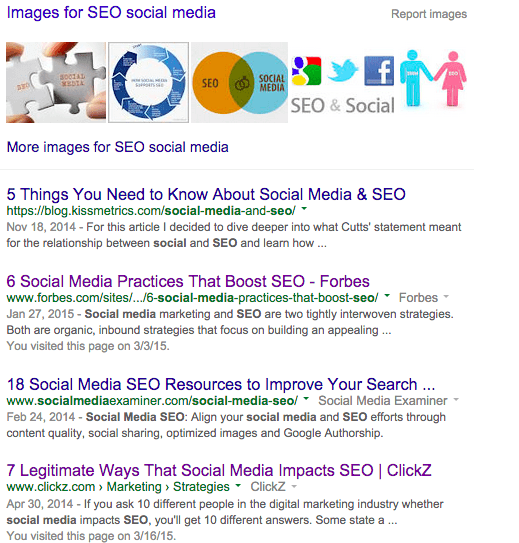Path Digital › News & Blog › SEO-social-SEO: understanding the relationship
SEO-social-SEO: understanding the relationship
by Nate Holman on September 19, 2015
/ 0 comments leave a reply
Today I wanted to take a look at how social media trends influence SEO…and vice versa. (Given the fluidity that typifies the digital space, we wouldn’t want it any other way.)

When I pull up a preliminary “SEO social media” search on Google, the first thing I notice isn’t the relevance of the results – or the results themselves. It’s that there are five, six, eighteen and seven things/practices/resources/etc, respectively, that I should know about the subject. That whole numbered-list thing.
What can I take from this observation? (Other than that the number of “things I need to know” is arbitrary.)
1) Cue-based recognition: it can lead to more socialized content and better rankings.
When it comes to digital experiences, as users we’re trained in medium/format-specific cue-based recognition – and in ways we don’t always explicitly notice. But they’re there. Just like on an actual road, there are cues on the ol’ digital information highway to get me where I need to go, quickly, so I can ignore the stuff I don’t need.
For example:
– Numbered lists (our brains like them because it “makes a very specific promise of what’s in store for the reader,” as Copyblogger puts it). When I see a numbered-list title, I instantly think blog or article. I don’t necessarily think well written blog or article; but in this instantly recognizable format I do tend to think there’s a promise of something useful. (Yeah, numbered-list articles have gotten excessive, maybe, but they work.)
– H2s and H3s in body text. It’s no coincidence these are directly applicable to on-page SEO. My experience as a user is improved when I visually break up content into bite-size chunks signaled by keywords I’m interested in. (And bonus points for creativity.)
– The hamburger/sandwich menu: ok, it’s a design element. It won’t show up in searches or feeds, obviously, but I would include it as a visual cue that can in certain scenarios speed time-to-recognition and – variables aside – aid analytics metrics. Despite the negatives I’d point out for desktop use, the hamburger menu is still finding its way to screen sizes larger than mobile.
On the last item, it will be interesting to see how user experience – and indirectly, site optimization – is shaped by icon-based conventions in the years ahead. You can see what Facebook’s doing with Facebook Reactions.
2) Social and organic search both emphasize cue-based recognition.
Social media and organic search behaviors both impact and emphasize cues like the ones above that we’ve been trained to recognize as users. To take the numbered-list example: though the “10 things you need to know about Y” or “5 ways to do X” articles can overwhelm my network feeds, I’ll often still click.
An increased likelihood to click/engage is based on very real user recognition principles, ones that can drive up traffic and search rankings. In turn, since network feeds and search results pages both aggregate content and, indirectly, experiences – each serving them up in their own way, of course – they can show us different cues and conventions that work most effectively today.
Memes, anyone?
“Memory Recognition and Recall in User Interfaces” (article first link in paragraph above) calls out three factors critical to recognition:
– Practice (here we can call this user “training”)
– Recency
– Context
It’s no coincidence that these are critical to SEO AND social. Context is obvious. It’s the digital “place” you find yourself in as a user, which analytics ties to bounce rates and SEO to keyphrases/keywords. Then there’s practice. To keep harping on the numbered-list example – it’s that tried-and-true titling that instantly informs me of the context I’m in. And from recency – an obvious factor for both SEO and social – comes design trends and the many reasons to keep both your content and experiences fresh and current.
3) And finally… SEO and social work better together.
Let’s start with SEO. As Google’s algorithms have evolved over the years to make the ranking process more natural (i.e., attuned to actual human users’ experiences) and thus SEO more equatable to “better UX,” optimizing your site has become more a question of how real users find, and interact with, the stuff they need. Rather than mechanically peppering your content with keywords, you focus on an experience that serves up content and meets user needs in a compelling way.
So an effective holistic SEO approach makes the experience familiar and approachable, it keeps the task simple and to-the-point, it ensures content is fresh and relevant.
SEO-social “synergy”
Sound like a good approach to your social media strategy as well? It’s no secret that the relationship can be synergistic and cyclical.
What we’re all wondering (as the search results show) is how Google’s SEO ranking factors are affected by social signals like likes, tweets, sharing, re-posting etc. Some factors are pretty obvious but important: things like virality and sharing on social media, for example, can impact brand presence and authority via increased citations/linking.
The key to social signals? Understand your users.
But it goes full circle. It’s critical that you get how SEO and UX together impact social media – and that users practice defined search-recognition behaviors to socialize with your brand.
Relevancy’s #1: just think about what you’re most likely to tune out in a Facebook or Twitter feed, for example, and then what’s most shareable. Like effective SEO, engaging social content first relates most effectively to the experience I expect to have as a user. The experience itself comes next.
Although these aren’t SEO “tips” per se, I hope the analysis is helpful as you 1) strategize ways to reach out to your digital base, 2) locate new audiences and customers, and 3) understand how SEO & social can work cohesively to impact your brand’s online presence and authority.
What have you found in your own work?

Through a Chicago-based SEO consultancy, Path Digital Services & Consulting, Nate offers custom, platform-oriented SEO services for small to midsize business and agency clients on WordPress, Shopify, Squarespace, BigCommerce and lots more. More about Path Digital ›
Leave a Reply